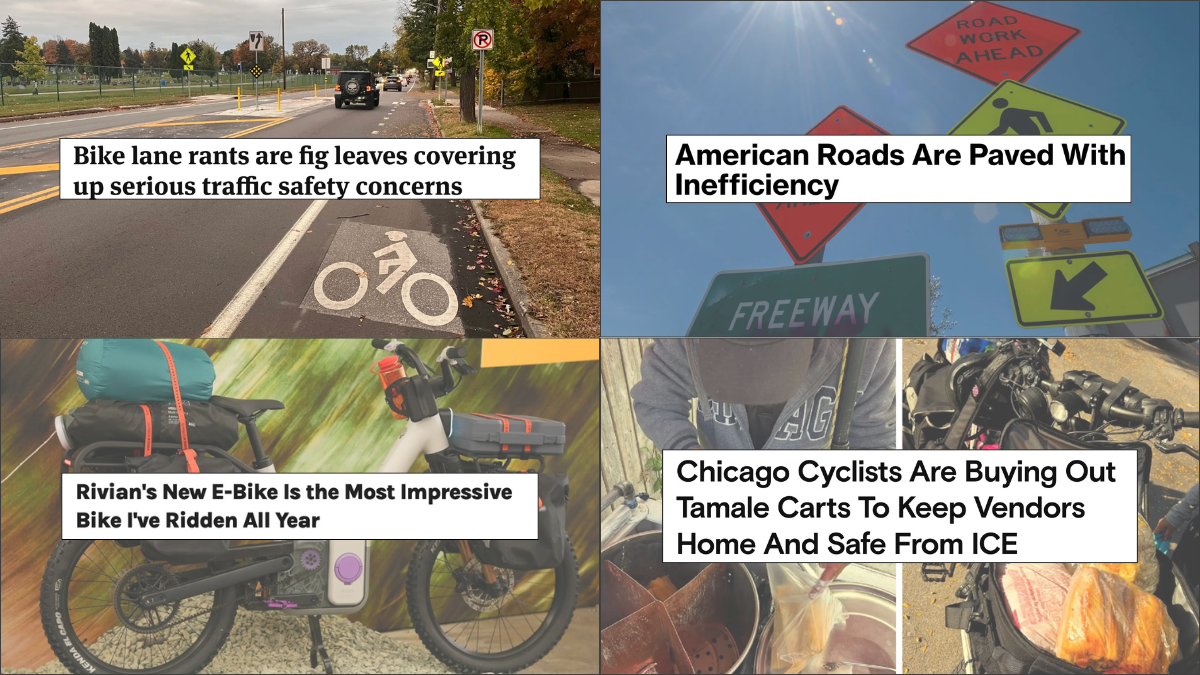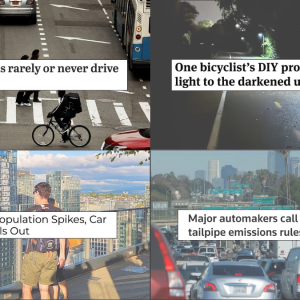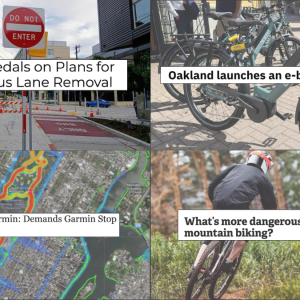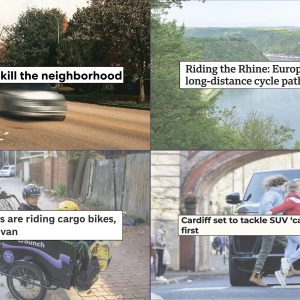Welcome to Monday. I was up early this morning to get this done before I head to the Hilton downtown for the opening plenary speeches at the MPACT Conference.
Below are the most notable stories I came across in the past seven days. Thanks to everyone who suggested links this week!
The story of BikePortland: A major journalism school featured BikePortland as a “Local News Bright Spot” in their widely-read annual report on local media in America. (Northwestern University Medill School of Journalism)
The bike lane fig leaf: Love this framing of how people (including DOTs!) focus ire and attention on bike lanes as a way to obfuscate the more difficult to address, underlying traffic issues. (Minn Post)
Rivian’s new e-bike: The road to the cycling revolution is paved with good intentions by big companies trying to disrupt the bike industry. It will be interesting to see what the future holds for Rivian’s spin-off bike brand, ALSO. (Velo)
Meme of the Week: If I had a dollar for every person who sent this “Local Kid Prepares To Dress Up As Bike Lane For Halloween To Really Frighten Elderly Neighbours” meme I’d be able to buy a nice lunch. (The Betoota Advocate)
Why highway projects cost so much: Quality of personnel and other factors lead to project cost bloat at some US DOTs. This is is a must-read for progressives who want to see more efficient and successful transportation projects. (I’ve been saying progressives must get better at leading the fiscal responsibility narrative.) (Bloomberg Citylab)
Cyclists stepping up: The long tradition of bicycle riders helping in crises continues in Chicago as groups of cyclists are buying out tamale vendors so they can stay home and stay safe from Trump’s Gestapo. (Block Club Chicago)
Some crashes are OK: When PBOT made major changes to SE Division Street, some of the haters used car crashes to argue the changes made the street less safe. This article gives important context to scenarios like that one and taught me the adage: “Better to have more cars in body shops and fewer people in body bags.” (The Happy Urbanist)
Cycling success in Glasgow: Every single time I read a story about a city moving the needle to create more bicycle riders there’s always some version of this line in the article: “Build safe, continuous, and visible bike lanes, and the bikes will come.” (Momentum Mag)
Brooklyn’s Bike Kill: I am so jealous of this event: Not only do I miss this type of freak bike culture energy in Portland, but as a cycling journalist I would have loved to have covered it! (The Guardian)
Thanks to everyone who sent in links this week. The Monday Roundup is a community effort, so please feel free to send us any great stories you come across.






Thanks for reading.
BikePortland has served this community with independent community journalism since 2005. We rely on subscriptions from readers like you to survive. Your financial support is vital in keeping this valuable resource alive and well.
Please subscribe today to strengthen and expand our work.
Another company turning bikes into overly complicated super expensive monstrosities NOT for the masses. Doesn’t seem like a good plan.
Judging by what I see out on the streets, there are plenty of people willing to drop $5K on a fancy, heavy, e-motor-bike. And it’s not like the masses are riding bikes of any sort.
Yeah but what you are seeing is ALL the people who were willing to do that. It’s not like Clever Cycles is sold out of Bullets.
90+lb, $4,500, e-motorcycle with pedals you can us to “charge the battery”, which no one is going to do.
No need to worry, I am just going to use my government subsidy to buy a bike I can’t afford to maintain.
Like water eroding a path through concrete; golf carts growing in the cracks of over-sized, over-powered vehicle dominance.
https://www.youtube.com/watch?v=FkHbNE9bfJo
I say, as long as the deputy makes sure each cart has a caddy, and every trip is recreational, then no ire will be raised from such irreverent behavior.
Are these the same car-like golf carts that BikePortland commentors claimed were going to make driving possible after the streets have become too rough and potholed for regular vehicles to traverse?
These the same golf cart-like golf carts that BikePortland commenters claimed were going to make driving safer and more efficient on paths that require less maintenance and capital investment. However, they may not be appealing to other commenters that would be disappointed that they can’t do Tesla-style Mad Max full-self-driving.
So they’d drive on a path that somehow couldn’t accommodate a car? Or would we’d say, for example, NE Williams is for golf carts only? After watching the video you posted, I have more questions than ever.
That said, if you want to drive the golf cart around Portland, I am not going to complain. I say: go for it, and stay safe!
We bought a used Fiat 500 E earlier this year. It’s basically a golf cart and it’s unbelievably fun. Driving anything bigger in town now feels like eating soup out of a ladle. I really can’t imagine why anyone wants to drive an SUV around downtown Portland or close in neighborhoods
I think the real issue is that many people can’t imagine driving to the mountains in a small vehicle (it’s fine, people, even in winter!). Around town is a secondary consideration.
Or they have a dog and think they need some huge vehicle to take it to the park (you don’t!).
A big dog in a small car is way cuter than the same dog in an SUV! (As long as you’re able to adequately secure the dog in your tiny car)
A large SUV would never work for my dog because he can barely reach the clutch as it is.
Presumably he’s missed his chance at driving school, but I’m sure he still looks fetching.
My lil fit ripped in the snow when I lived in Idaho
Great post on Protopia. Reminded me of the book by Brooklyn Spoke author (Doug Gordon) and others, which came out recently: Life After Cars. The section on Bikelash is fantastic.
The Rivian e-motor-bike, while cool, shows us how far we’re straying from what bicycling is.
Username checks out!
While I agree with you on the “straying” part, I couldn’t disagree more on the “cool” part. To me, that thing looks like a box of smashed assholes.
It reminds me of whoever that is who has on a couple articles come in to troll that he rides his four wheel e-bicycle everywhere (and goes on to plainly describe an electric car).
That bike, although elaborate, doesn’t seem all that different from a Tern. The decoupled pedal input is bizarre, but interesting.
I’m a bit surprised actually with how inexpensive it actually is. Still expensive, but not an outlier. I wonder about the components and how proprietary and weird it will be.
I originally thought it was a troll at first (my post asserting such got blackholed), but then I googled it. I now think it’s a real thing, just as he described it. No different than an electric trike except with 4 wheels. We now have a spectrum more than discrete categories.
My definition may be different than yours, but to me a bike is an unmotorized vehicle. Always has been, always will be. An e-bike is a low powered motorcycle with pedals. It’s fine to ride one, it’s just not a bicycle. It’s a bimotorcycle.
That’s my take as well. I like that it only goes to 20 MPH with throttle only but will give you more boost if you pedal. I don’t like the 28 MPH top end generally on off-street paths particularly. But, this is way better than the e-motos that are out there going super fast with throttle only.
Other car manufacturers have always just taken a regular bike and rebranded it. Somehow it would be prestigious to ride a Cadillac bicycle that’s nearly the same as a Walmart bicycle. I’m impressed that Rivian has used their engineering prowess to try some next gen technology out. For everyone? Nope! But, neither are e-bikes in general. While the new tech is for the early adopted, this bike isn’t much different than many e-bikes already on the road.
Comment of the week. Riding a bike is sort of a dance and e bikes at their worst lose the lightness, nimbleness, and feedback of a good bike. Who wants a partner that can’t spin?
I’m happy to see some thought put into the drivetrain and controls of an e bike but without having ridden it I’m afraid Rivian is doing Bike As Car, grossly overpowered but weirdly without fenders. Is the feedback to the rider intuitive or more like an ’80s friction drag exercise machine that goes fast on two wheels?
My current ideal of a power assisted bike would be a mid length hard tail with short travel front suspension, frame mounted front platform, sturdy rear rack, friction shift 3×7 rear, roomy stock fenders and lights, with front hub e assist and a controller set up to input power smoothly after rolling off at minimum torque. Front braking would be automatic regeneration backed up by rim braking under heavy pressure, plus a rear disk brake.
Of course I haven’t ridden anything like that because some of that stuff doesn’t exist, and there’s no point shopping for a redundant fancy bike that I can’t afford. I do have a notion to experiment with front drive because it’s a way to add a moderate amount of power without kludging the drive train. Among other things it might work for riding on the second and third day after a heavy wet snow, with a 42C or larger studded tire.
On any bike that needs extra controls they should be easy to locate without looking, weatherproof, and operable with gloves on. Some e bike crashes may be caused by riders looking for buttons or scrolling displays. Rivian seems to have put some thought into their screen at least.
An e bike can be a little chunky without losing rideability but at 90 pounds you need a garage. It’s hard to street park but thieves could grab it and jailbreak it later. Some e bikes need a heated space for charging. . .I sometimes remove my battery to deter thieves but a dismounted proprietary controller might be an interesting way to help secure a street parked e bike.
As the heavy e bike arms race goes on, I think the first walking reverse gear will score some points. Undocking a loaded bike can be a challenge. Also it’s no fun backing and filling a heavy bike into the spot where you can reach a beg button.
“My current ideal of a power assisted bike”
Mine is me on my bike with a can of Four Loco. It avoids almost all of the problems you listed.
Had an unexpected week in Glasgow last year (family emergency). Ended up renting a bike (only 60 GBP for a week!) to get around in combo with light rail, and it was a fantastic experience. Only annoying parts were that the M8 motorway is as big and frustrating a barrier right through the heart of the city as I-5 is here, and some train stations can only be accessed by stairs/escalator.
But man they have so many miles of walking/biking trails, including extensive trails along the River Clyde, protected/separated bike lines, pedestrianized areas with wide sidewalks. Just a wonderful place to ride around both for fun and for transportation.
Two years ago, almost to the day, my wife and I spent two days in Glasgow after finishing a long trek in the Highlands. Glasgow was great! We got around by train, bus and on foot. I especially enjoyed our visit to the Riverside Museum (Museum of Transport). I thought their exhibits on public and active transportation were very well done. Several bicycling-related displays caught my eye: World’s Oldest Bicycle?, Cycling and the Workers, and Bicycle Built for Four. If I remember right, I sent Jonathan a photo of the world’s oldest bicycle. I assume you’ve been there, but if not and you’re interested, you can see my photos on Flickr.
“I’ve been saying progressives must get better at leading the fiscal responsibility narrative”
Fiscal responsibility in Portland? Yeah, that’s a laugh, mate. Between the PCEF slush fund , the failed homeless tax, and that preschool plan for about three kids tops, it’s less budgeting and fiscal responsibility and more burning cash on a barbie, gifting it to the elected’s favored nonprofits (which are also their political supporters). Progressives and prudence, oil and water if I’ve ever seen it
I bet I’m not the only one who preemptively rolls their eyes as soon as we see your name in the comments.
I choose to view them as performance art.
Like bikkies in the bonfire, cobber.
Don’t forget the 5 families of Portland downtown real estate burning through tax dollars.
Then there’s also the construction companies that profit on the tax payer’s dime for building over priced buildings and useless Max tracks.
Sad to say most communities suffer at the whims of the rich and powerful who run (ruin) our city’s behind the scenes.
Mazel tov on the shout out from Medill! But I would quibble with, “there’s always some version of this line in the article: “Build safe, continuous, and visible bike lanes, and the bikes will come.”” I think it’s more “build like safety and wellbeing are the highest priority, and everyone will be safer and better.” Everyone might even include the rest of the ecosystem, not just humans!
If people want to buy with their money Motorcycles like the Rivian, I welcome them as long as they use regular streets and car travel lanes as Motorcycles should, no problem.
I don’t want to share my 3 foot bikelane with motorcycles, but they are better than big cars…
On 2 way bike lanes Bullets and large cargo bikes scare the crap out of me at times.
A head on crash with a loaded cargo bike doing 20-25 would crush my regular bicycle like a car would.
Buy one, drive it like the motorcycle it is and everything will be fine.
Is a driver’s license with motorcycle endorsement, license plate, and liability insurance a requirement for operating a e-moto what you envision an appropriate level of regulation?
I’m starting to lean that way but I’d also like the rental scooter operators lock out people who ride down on way streets traveling the wrong direction.
The max weight of a bullit plus rider and cargo is about 460. Topped out.
That may be scary, but any regular bike with a 200+ pound rider is more than half that. Add a couple paniers and you’re getting in the ballpark (300 pounds easy). And they can go just as fast as a bullitt, easy, since they are class 1, 20mph max assist. So yes, they’ll still crush your bike, just like any large rider going fast. Do you gate keep large riders and insist they stay off the paths?
And keep in mind, that is MAXED out. I can tell you from experience, it feels scary going fast with loads approaching that. Our roads aren’t smooth and those bikes don’t have dayy tires. So I don’t believe you ever actually see a fully loaded cargo bike going 20-25. You see them with one or two kids and a few things. Much closer to the regular bike plus large rider.
So just keep things in perspective before you lose your mind at people riding around on cargo bikes. On mups. It’s fine, you’ll be ok. The rider is almost always the heaviest part of any bike plus cargo. Worry about the cars.
It’d have roughly less than 1/10th of the kinetic energy and momentum of a light sedan going the same speed.
Fantastic point Paul H. Looking at this from a physics perspective removed from a sort of historical car blindness, rather than an ideological one, seems to be a step in the right direction. The reason a lot of cities restrict auto speeds to around 30kph is the survivability probability in case of collision. Let’s not forget the first pedestrian (i.e., H. Bliss) killed by a car was killed by an electric car.
But the motor type fact is entirely immaterial. It’s impact force that’s the big factor, and that depends on vehicle/thingy height, weight, speed etc. Let’s not be blinded by fear of the scary new thing and it’s associated stereotype rider, whatever it is.
“Motors are immaterial now….”
Talk about a Car Head.
No one is blinded by this “new”thing.
Motorbikes are not bicycles.
Ebike accidents and injuries are soaring, you would think a statistics guy might have those to share with us, its an easy google search.
Crash dynamics involve more than raw energy — being catapulted off a bike and onto the pavement can be deadly even at very low collision energies (hitting a loose skateboard, for example), and some high energy crashes are not particularly dangerous; imagine being pushed slowly by a heavy truck. High energy, but low injury potential.
So I would not downplay the injury potential posed by a cargo bike which might, unlike a car, be sharing the same space with other bike riders.
I’m not downplaying risk of injury. But I do doubt that in a collision, the bicycle frame would be “crushed”
I didn’t interpret “crush” literally. But if you did, you’d be right — one bike is unlikely to crush another, no matter how fully loaded or how powerful the motor.
Of course, crushing is more a function of mass and geometry rather than impact energy, at least in the realm we’re discussing.
Yes, and in BB’s hypothetical, the cargo bike and care are going the same speed, so the only difference is the mass and stability cars vs cargo bike.
If a bike and a loaded electric cargo bike collide, both are going to fall over and dissipate some of the impact energy. Cars tend to stay upright when they collide with bikes.
There are speed limiters built into legal e-bikes. There *no speed limiters built into cars*.
Cars kill thousands of pedestrians and cyclists every year. E-bikes kill how many, again?
Maybe it’s an artifact of my online-forum-reading habits, but why am I ten times likely to read an argument for greater regulation of e-bike technology than automobile technology?
I understand the sentiment that we should look carefully at any addition to our MUPS, bike lanes, etc. I also sympathize very strongly with anyone who is beyond annoyed at the dirt-bike kids riding on our MUPS.
On the other hand, the amount of internet ink spilled on *e-bikes* is disproportionate to their ills, compared to the obvious manifest ills of cars.
I think that status quo bias has colored our reasoning: we’re used to cars everywhere, cars that are built to go 100mph, cars that are tested by going 0 to 60 (as if there’s any legally defensible reason a minivan driver would ever need to do so), and car drivers killing pedestrians on a weekly basis, but we’re just not used to e-bikes.
It’s hard to imagine a world where we regulate the construction of the many millions of powerful motor vehicles, built by large, connected multinational companies, and driven by millions of American consumers/voters.
It’s a lot easier to imagine a world in which the relatively small and politically weak world of bike manufacturers and bike riders are punitively regulated because of overblown concerns.
The problem is, swinging the regulatory hammer down on e-bikes and e-bike riders would do almost nothing to reduce human fatalities on our streets, while the march of automobile fatalities would continue unimpeded.
https://www.facs.org/for-medical-professionals/news-publications/news-and-articles/bulletin/2024/julyaugust-2024-volume-109-issue-7/electric-bikes-are-emerging-as-public-health-hazard/
Doctors and surgeons disagree with you that the dangers are overblown as you say.
Motor bikes are clearly way more dangerous than bicycles.
Ride them, enjoy them, but they are not like bicycles from a death and injury standpoint.
BB:
“I welcome them as long as they use regular streets and car travel lanes as Motorcycles should, no problem.”
It’s ironic that you say this, because one of the risk factors mentioned in the public health study you promoted is that e-bike riders face greater risk of death because they are riding in the automobile travel lane, instead of bike lanes!
“E-bike riders are more likely to sustain fatal injuries after collision with a motor vehicle, which can partially be attributed to e-bike riders frequently sharing the road with cars and not using dedicated bicycle lanes.”
You’re saying that e-bikes are so dangerous that they should not be allowed in bike lanes, and you’re also pointing to a study that says part of the increased risk is that not riding in the bike lane subjects an e-bike rider to a greater risk of death from cars.
Sometimes it feels like e-bike critics just wish I didn’t exist, and here you are practically saying that’d it’d be fine for me to ride my e-bike as long as I face an increased chance of dying after getting hit by a car.
So you’ll have to forgive me if I do not believe that you have my best interests at heart.
Furthermore, I have two thoughts about the study in question:
A. As Maus and many others of us regularly point out, “e-bike” is a term that is used liberally, to encompass as diverse a set of vehicles as cargo bikes carrying kindergartners, lightweight road bikes with a class III motor, and heavy, fast dirt bikes that have an electric motor, rather than a gas motor.
Since the text of the article does not define the term, and since I’ve read many, many news media articles that simply say “e-bike,” when “dirt bike” would be more accurate, I think we should be cautious to lump someone like “a bike commuter on an e-bike” into our analysis. I’m not saying that there’s no increased risk (the physics of speed being what they are), but rather that an effective regulatory response needs to be specific to the actual problems.
A similar example: we bemoaned the increase in pedestrian fatalities in Portland during the last five or six years, and I think a lot of Bike Portland readers feel personally at greater risk. However, reporting has also shown that very many of the deceased were people living on the streets, in the throes or mental health crisis, or under the influence. An effective public health response will take that fact into account.
I’d like to know more about this, but the study does not address it!
B. There’s a fundamental mathematical problem in studying the relative danger of e-bikes vs bikes, which is that there are two confounding factors:
1. an increase in human fatalities overall occurring at the same time as the widespread adoption of e-bikes
2. the increasing share of bike riders on e-bikes
If people riding e-bikes are at greater risk at the same time that we are all at greater risk, then how can the study’s authors conclude that it’s the fault of the e-bike? Or, at least, could they assign a percentage of the increased risk to the kind of bike itself, as opposed to general conditions of increased risk on streets? The article does not address that!
Second, if we are to compare the relative dangers of different kinds of bike, wouldn’t we need to know what percentage of riders are on e-bikes? Maybe all that the doctors have observed is an increase in “miles traveled on a bike of any kind,” in which case an increase in injuries might just be a mechanical result of an increase in travel on bikes. In that case, while e-bikes are the cause, it’s only because e-bikes were attractive enough to people to get them to starting riding some kind of bike, period. As I often say to myself, “the best way to avoid a bike crash is to never ride a bike.”
As before, the authors do not address this statistical difficulty in the text.
C. We can quibble all day long about what I meant by “overblown”, and whether this article is correctly blown or not, but I will leave it at this:
Since the authors of the study never untie the confusion of threads I’ve enumerated above, I remain unconvinced that your proposed regulatory solution (“I welcome them as long as they use regular streets and car travel lanes as Motorcycles should”) is workable, humane, or necessary.
In fact, since the study specifically calls out that riding in car travel lanes is more dangerous, all you are really arguing for is more cyclists to die. That’s a shitty, shitty argument. One might even say it’s overblown.
Because it’s new and people are riding these motorized vehicles in places traditionally reserved for human powered travel. There are in fact lots and lots (and lots) of regulations for automobile technology (and we require state licensure, vehicle registration, and liability insurance to drive one), and hardly any for e-bike tech, so the world you are trying to imagine exists all around you.
E-bike speed limiters are opt-out; car speed limiters are opt-in. But cars need to be capable of highway travel, so limiting them to 28 mph would severely limit their utility.
Perhaps we could have a class of car-like vehicles (we could call them golf carts) that anyone could drive on any city street, bike lane, or MUP, up to 28 mph, with no licensing, insurance, or real safety requirements. Would that make you feel safer walking or riding your bike? Not me.
I do agree that addressing problems with e-bikes is not likely to change anything in regards to cars, or any other dangerous items that are not e-bikes.
There’s a thing about the Rivian bike that feels shocking and offensive to me, someone that really believes that the three true virtues of a bicycle are its being cheap, simple, and small. Well, I’m not really sure what “small” means… cheap and simple I like and feel strongly about, and then I feel like there should be a third one, so maybe it could be “slow” or whatever else has a good ring to it.
That feeling is useful, and the Rivian bike is useful in provoking it, to challenge my thinking. How simple and cheap is a bicycle, really? A couple hundred years ago we just barely had the technology to get rolling on two wheels. We take chain drive, pneumatic tires, freehubs, cable-operated derailer gears, and strong cable-operated brakes for granted. These were all high technology when they were developed, and most of us couldn’t fully describe how any single one of these technologies work. OK, in this comment section there might be a few of you — I’ll freely admit that I only know how any of these things work in broad terms. They’re “simple” and “cheap” in the grand scheme of a big, complicated, interdependent industrial civilization and they have been for my entire life.
The bicycle is special to me because it feels like an extension of my body. Most of the mass of the bicycle-rider system is the rider. My body provides the power, my body must lean with turns. But I still have to contort my body into a position to reach the grips and pedals — the bike is fit to my body, but I also fit my body to the bike. It is a system, too. It’s just a smaller one than… a smaller one than… the car. There it is. The car.
The bike is a humbler thing than the car that envelops us. It’s cheaper and simpler, smaller or slower than. More individual than, more compatible with pedestrians than. Maybe none of the things I love about bicycles are absolute — my love is maybe tied up in a conservative impulse, one that resists being pulled into some system that feels less connected and human, and like many conservative impulses the past it clings to is a moment in time that’s always slipping away. At one moment it may resist derailers and brakes; at another, it may resist integrated shift/brake levers and carbon fiber. At one moment it may resist hydraulic brake lines, 10-speed hubs, electronic shifting. Suspension and dropper posts. A drive motor. I sigh deeply. A regenerative braking system. A drive-by-wire pedal system.
OK, sorry, I know I’m not a good enough writer to actually pull that “sigh deeply” shit off :-P. But you know what I mean. Maybe some of what’s on the Rivian will become a core part of bikiness for a generation and my old ass puttering down the bike lane under human power will be as annoying as a guy in rollerblades jogging his dog is today. I think that’s part of the fear — ubiquitous use of these things is going to push us (us! whoever we are!) off the bike lanes like cars push us off the roads. I’ve gotta say, I don’t like the Rivian bike, it’s not for me (at least not right now), and more than that, it feels to me like something that’s not a bike. But… I know that what it is that I’m clinging to isn’t hard, it’s slippery, it’s of-a-time, it’s contingent. I’ll try not to be so much of a hater it’s embarrassing (I guess).